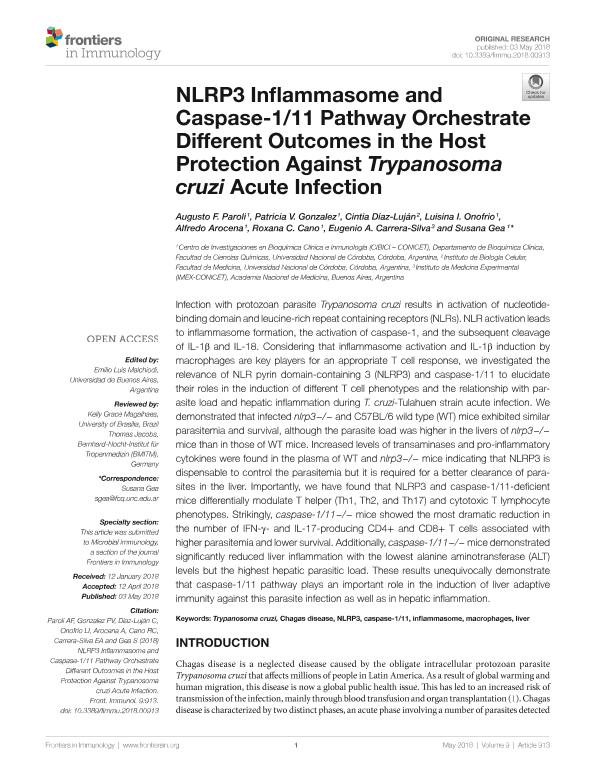Mostrar el registro sencillo del ítem
dc.contributor.author
Paroli, Augusto Fabián

dc.contributor.author
Gonzalez, Patricia V.
dc.contributor.author
Díaz Luján, Cintia María

dc.contributor.author
Onofrio, Luisina Inés

dc.contributor.author
Arocena, Alfredo Raul

dc.contributor.author
Cano, Roxana Carolina

dc.contributor.author
Carrera Silva, Eugenio Antonio

dc.contributor.author
Gea, Susana

dc.date.available
2020-01-27T19:23:28Z
dc.date.issued
2018-05
dc.identifier.citation
Paroli, Augusto Fabián; Gonzalez, Patricia V.; Díaz Luján, Cintia María; Onofrio, Luisina Inés; Arocena, Alfredo Raul; et al.; NLRP3 Inflammasome and Caspase-1/11 Pathway Orchestrate Different Outcomes in the Host Protection Against Trypanosoma cruzi Acute Infection; Frontiers Media S.A.; Frontiers in Immunology; 9; 5-2018; 1-12
dc.identifier.issn
1664-3224
dc.identifier.uri
http://hdl.handle.net/11336/95893
dc.description.abstract
Infection with protozoan parasite Trypanosoma cruzi results in activation of nucleotide-binding domain and leucine-rich repeat containing receptors (NLRs). NLR activation leads to inflammasome formation, the activation of caspase-1, and the subsequent cleavage of IL-1β and IL-18. Considering that inflammasome activation and IL-1β induction by macrophages are key players for an appropriate T cell response, we investigated the relevance of NLR pyrin domain-containing 3 (NLRP3) and caspase-1/11 to elucidate their roles in the induction of different T cell phenotypes and the relationship with parasite load and hepatic inflammation during T. cruzi-Tulahuen strain acute infection. We demonstrated that infected nlrp3-/- and C57BL/6 wild type (WT) mice exhibited similar parasitemia and survival, although the parasite load was higher in the livers of nlrp3-/- mice than in those of WT mice. Increased levels of transaminases and pro-inflammatory cytokines were found in the plasma of WT and nlrp3-/- mice indicating that NLRP3 is dispensable to control the parasitemia but it is required for a better clearance of parasites in the liver. Importantly, we have found that NLRP3 and caspase-1/11-deficient mice differentially modulate T helper (Th1, Th2, and Th17) and cytotoxic T lymphocyte phenotypes. Strikingly, caspase-1/11-/- mice showed the most dramatic reduction in the number of IFN-γ- and IL-17-producing CD4+ and CD8+ T cells associated with higher parasitemia and lower survival. Additionally, caspase-1/11-/- mice demonstrated significantly reduced liver inflammation with the lowest alanine aminotransferase (ALT) levels but the highest hepatic parasitic load. These results unequivocally demonstrate that caspase-1/11 pathway plays an important role in the induction of liver adaptive immunity against this parasite infection as well as in hepatic inflammation.
dc.format
application/pdf
dc.language.iso
eng
dc.publisher
Frontiers Media S.A.

dc.rights
info:eu-repo/semantics/openAccess
dc.rights.uri
https://creativecommons.org/licenses/by/2.5/ar/
dc.subject
CASPASE-1/11
dc.subject
CHAGAS DISEASE
dc.subject
INFLAMMASOME
dc.subject
LIVER
dc.subject
MACROPHAGES
dc.subject
NLRP3
dc.subject
TRYPANOSOMA CRUZI
dc.subject.classification
Inmunología

dc.subject.classification
Medicina Básica

dc.subject.classification
CIENCIAS MÉDICAS Y DE LA SALUD

dc.title
NLRP3 Inflammasome and Caspase-1/11 Pathway Orchestrate Different Outcomes in the Host Protection Against Trypanosoma cruzi Acute Infection
dc.type
info:eu-repo/semantics/article
dc.type
info:ar-repo/semantics/artículo
dc.type
info:eu-repo/semantics/publishedVersion
dc.date.updated
2019-10-18T18:02:28Z
dc.journal.volume
9
dc.journal.pagination
1-12
dc.journal.pais
Suiza

dc.journal.ciudad
Lausana
dc.description.fil
Fil: Paroli, Augusto Fabián. Consejo Nacional de Investigaciones Científicas y Técnicas. Centro Científico Tecnológico Córdoba. Centro de Investigaciones en Bioquímica Clínica e Inmunología; Argentina
dc.description.fil
Fil: Gonzalez, Patricia V.. Consejo Nacional de Investigaciones Científicas y Técnicas. Centro Científico Tecnológico Córdoba. Centro de Investigaciones en Bioquímica Clínica e Inmunología; Argentina
dc.description.fil
Fil: Díaz Luján, Cintia María. Universidad Nacional de Cordoba. Facultad de Medicina. Instituto de Biologia Celular; Argentina
dc.description.fil
Fil: Onofrio, Luisina Inés. Consejo Nacional de Investigaciones Científicas y Técnicas. Centro Científico Tecnológico Córdoba. Centro de Investigaciones en Bioquímica Clínica e Inmunología; Argentina
dc.description.fil
Fil: Arocena, Alfredo Raul. Consejo Nacional de Investigaciones Científicas y Técnicas. Centro Científico Tecnológico Córdoba. Centro de Investigaciones en Bioquímica Clínica e Inmunología; Argentina
dc.description.fil
Fil: Cano, Roxana Carolina. Consejo Nacional de Investigaciones Científicas y Técnicas. Centro Científico Tecnológico Córdoba. Centro de Investigaciones en Bioquímica Clínica e Inmunología; Argentina
dc.description.fil
Fil: Carrera Silva, Eugenio Antonio. Consejo Nacional de Investigaciones Científicas y Técnicas. Instituto de Medicina Experimental. Academia Nacional de Medicina de Buenos Aires. Instituto de Medicina Experimental; Argentina
dc.description.fil
Fil: Gea, Susana. Consejo Nacional de Investigaciones Científicas y Técnicas. Centro Científico Tecnológico Córdoba. Centro de Investigaciones en Bioquímica Clínica e Inmunología; Argentina
dc.journal.title
Frontiers in Immunology
dc.relation.alternativeid
info:eu-repo/semantics/altIdentifier/url/http://journal.frontiersin.org/article/10.3389/fimmu.2018.00913/full
dc.relation.alternativeid
info:eu-repo/semantics/altIdentifier/doi/http://dx.doi.org/10.3389/fimmu.2018.00913
Archivos asociados
